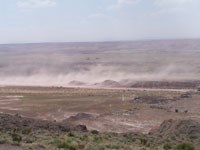

Photo by Aimie Knight/NPS Snow and rain occur throughout the winter months, from as early as October to as late as March. Although snow quickly melts, the moisture leaves the colors within the Painted Desert vibrant in the crisp, cool air. 
Photo by Marge Post/NPS The average relative humidity of the area is well below 50%, at times less than 15%, making even the hot summer days quite tolerable. Weather records show that the average June relative humidity is 26%, while the average August humidity is 47%. Because clear nights allow for rapid cooling, temperatures in Petrified Forest National Park can vary as much as 40 F between the highs of daytime and the lows of night. Summertime temperatures, from late May to early September, are in the mid to high 90s F, yet go down to the mid 60s F overnight. Winter temperatures, November to March, often average in the teens and 20s F at night with daytime sunshine warming the area up to the 40s or 50s F. 
Photo by Marge Post/NPS Northeastern Arizona is the windiest section of the state. The relatively flat, lightly vegetated plateaus and valleys do very little to slow air movement. A consistent summer breeze averages around 10 miles per hour. Mornings tend to be calm with afternoon heat creating stronger wind patterns. Winds of late winter and spring regularly reach 40 miles per hour and sometimes gust at 60 miles per hour! Although the summer breeze helps moderate the heat, the winter wind can add a biting chill to the air. |
Last updated: December 15, 2019
